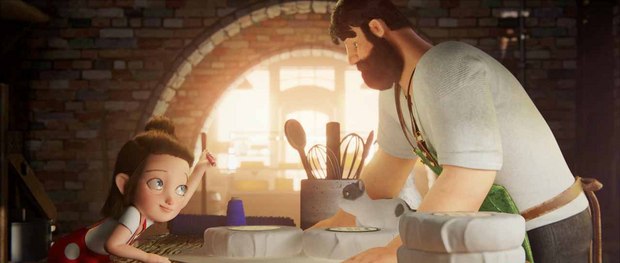Touching 3D Short launches Dairy Farmers of Canada ad campaign.
Creative production company Gentleman Scholar recently teamed-up with DDB Canada and Dairy Farmers of Canada (DFC) to produce an animated, 3.5-minute short film at the heart of a new campaign to help elevate the quality perception of Canadian cheese. The campaign officially launched this week, with the short debuting on the brand’s YouTube channel together with several :15 and :06 cut-down versions.
With new trade laws soon making imported cheese more accessible to the Canadian consumer, DFC has crafted a narrative that establishes Canadian cheese as a global competitor and an indulgence worth exploring. With the millennial target in mind, the campaign suggests that what separates Canadian cheese from imported European cheese is the creativity of Canadian cheese makers.
“Rather than tread the well-worn ‘traditionally crafted, artisanal quality’ story typical of cheese advertising, we share a new story for Canadian cheese,” explained DDB’s executive creative director Paul Wallace. “Inspired by a cultural mosaic of traditions, peoples and tastes, Canadian cheese-makers are unburdened by tradition, leaving them free to craft new, creative cheeses in any manner their hearts desire.”
Set in a charming cheese shop, “Mia and Morton: A Story of Canadian Cheese” spotlights an aging cheese-maker and his energetic daughter, who also happens to be his apprentice and his muse. Spanning the period where Mia grows from child to young woman, Morton’s creatively crafted cheeses perennially come up just a little short at the annual international cheese championship. Rose Cousins’ performance of a simpler version of Fleetwood Mac’s “Don’t Stop Thinking About Tomorrow” provides the film’s touching soundtrack. As the song builds, with inspiration from Mia and family pet Monty, the cheese-makers persevere together, eventually bringing home the grand prize.
Gentleman Scholar’s creative directors William Campbell and Will Johnson seized on this storytelling opportunity.
“The initial script for this project is actually very close to what you see on the screen… in terms of the overall emotional arc and a lot of the moments,” says Campbell. “One of our key contributions was helping to capture the essence of time passing, and visually communicating the changes in the relationship between Morton and Mia. That was such an amazing emotional journey to be able to dive into.”
“While we met Morton and Mia in the script – when it came to who they were, what their story was and the nuances of their performances, all of that was left for us to craft,” adds Johnson. “We really dove in with the character development, the world building, the development of their spaces and the textures of materials. We brought life into Monty the cat as well. For everyone here, it was really important to craft the look and feel of these characters as a family unit, and how their personalities came through in the animation.”
To develop the project, the co-directors along with executive producer Jo Arghiris, head of production Rachel Kaminek, senior producer Tyler Locke, art director Paul Kim, CG supervisor Tim Hayward and dozens of others spent extra time in the previs stages, focusing on keeping the visual story simple and authentic.
Key tools included Autodesk Maya, which was used for modeling, The Foundry’s Nuke software for compositing and Adobe’s After Effects for finishing.
With the emphasis on storytelling sophistication and given the project’s length, one internal challenge had to do with quality control. According to both Campbell and Johnson, the Redshift GPU-accelerated 3D rendering software played a vital role. “Animations always look different from the greyscale previs to the render; there are always things you only notice once you see things fully rendered,” Campbell says. “By performing so much faster than tools we’ve used in the past, and thereby allowing us to iterate and see more works-in-progress earlier on, Redshift had a big impact on the way this project turned out.”
Source: Gentleman Scholar











